The Hybrids Bible, covering everything you need to know about hybrid vehicles and engines and much more.
The Hybrids Bible
Why do hybrid vehicles make sense?
You've no doubt heard of hybrid cars by now, most likely the Toyota Prius. More manufacturers are jumping on the hybrid bandwagon, but just what is a hybrid car? Simply put, it's a vehicle that uses a combination of two technologies to drive it. Why does it make sense? Easy - as simple a change as a pure series hybrid configuration can cut the amount of fuel you use by half, and emissions by 90% - something which was proved ages ago - see aXcessaustralia. GM proved the same thing but then actively killed both the EV1 full electric vehicle and the EV1 series hybrid which at the turn of the millenium could break 100 mpg. I'm not going to get into the bribes and political maneuvering that caused the GM decision - if you're interested, the film Who Killed The Electric Car has more than enough information in it to make you boil with anger.
Helping to solve the mpg problem
The real limitations on gas-mileage in today's cars are:
- Internal friction in the vehicle. This can be helped by swapping to electric, or at least hybrid electric, systems and drive-by-wire, with motors in the wheels)
- Friction on the vehicle caused by the ground on the tyres. This can be helped by swapping to low-profile low-rolling resistance tyres, as mandated by law in California, and by reducing the vehicle mass using more carbon fibre, aluminium and plastics)
- Friction on the vehicle caused by air resistance/drag. This can be helped by altering the vehicle profile to better match a teardop shape or airfoil, as has been done to a certain extent with the Prius and more so with Mercedes' Boxfish concept car). See the mini section on aerodynamics later on for more info on this.
If you do consider the three factors above, then even the clunkers of today could manage over 100 mpg, and minor improvements in the future could easily yield a 200 mpg family car (actually, an affordable 100+mpg family car could have been manufactured by the big companies and on sale at a reasonable cost back in 2002, with 150-200 mpg cars hitting the market by 2009). So we know what the problems are, and things are moving ahead albeit slowly. Here then is some information on the heart and soul of a hybrid car : the engine.
Hybrid Engines
The most common hybrid cars are petrol-electric, like the Prius. Petrol-electric hybrid cars use a normal petrol engine, just like you'd find in any other car, but in addition, there are one or two high-torque electric motor-generators. The motor-generator(s) draw power from a bunch of car batteries stored either in the floorpan of the car (for a low centre of gravity) or in the rear (for convenience). With power supplied to the motor-generator, it behaves like an electric motor. When no power is supplied but the shaft is turning, it becomes a generator to create power. In this mode, you get regenerative braking, where the energy required to slow the vehicle down is all taken up in the motor-generator to re-charge the battery packs. Both the petrol engine and the motor-generator(s) are connected to an onboard computer system which has been programmed by men in white coats to work as efficiently as possible. There are three mainstream technologies in the hybrid market at the time of writing, each championed by a different company or group of companies. Note: the diagrams below all show rear wheel drive for ease of explanation, but hybrid drives can be any of the standard drivetrains from front wheel only to 4-wheel drive.
IMA - integrated motor assist (Honda)

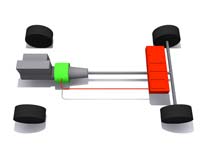
The motor-generator (electric motor and regenerative generator) is in-line with the petrol engine, typically built into the bell-housing in front of the gearbox. The motor-generator is used to assist the petrol engine, thus reducing the load on it and allowing it to be smaller than it would otherwise be for a vehicle of the same weight. For example the Civic hybrid uses a 1.3l engine where the non-hybrid uses a 1.8l engine. The motor-generator cannot turn without turning the petrol engine too. First-generation systems didn't have enough power to be able to run the car on electric alone. Current generation ones do through higher powered motors and the ability to shutoff the petrol engine when coasting. Because the motor-generator is in-line, the regenerative braking works very simply - as you start to brake, the motor becomes the generator. Conversely it is also used as the primary starter motor for spinning the petrol engine up quickly after it has been turned off, for example at traffic lights. There is also a backup 'regular' starter motor for cold-starts and emergencies. Of the three mainstream hybrid technologies, IMA is by far the simplest to implement, maintain and repair. In the following images, red is the battery pack, green is motor-generator 1 and blue or purple is motor-generator 2.
Hybrid Synergy Drive (Toyota)

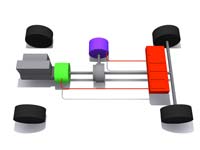
Toyota's take on hybrid drive has a pair of motor-generators, one in-line like the Honda IMA design, one not. The key to its success is the compound planetary gearset in the transmission. In the Toyota system, the petrol engine and one motor-generator are connected to one of the inputs, the second motor-generator to the second input and the wheels to the third. Through a clever use of electronics, the planetary gearbox can be locked and unlocked in various configurations dependent on what is required. For example under modest acceleration, the petrol engine drives the planetary gearbox as well as the first motor-generator. The output from that is fed to the second motor-generator along with the output from the gearbox to drive the wheels. In pure electric mode, the first motor-generator freewheels, the petrol engine is turned off and all the electric power is fed to the second motor-generator. Under regenerative braking the second motor-generator becomes the generator as it does in the IMA system above. The difference is that if the battery pack is full, the energy derived from the second motor-generator is redirected to the first motor-generator which in turn uses it to induce drag in the petrol engine to slow the vehicle down. As a result, the actual brakes in a Toyota Hybrid car do not wear very quickly at all because most of the braking is provided by the motor-generators. Only in severe cases do the brake pads actually engage the brake rotors. This is all made possible by the central engine computer and throttle-by-wire / brake-by-wire system.
Dual-mode or 2-mode Hybrid (GM).

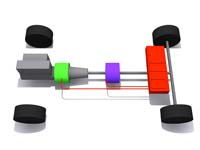
The third hybrid system comes from GM and has two operating modes as oppose to the single mode of IMA or HSD. It again uses two motor-generators. In first and second gears, the first motor-generator sends power to the second motor-generator, and that coupled with the petrol engine provide the power to the wheels. In higher gears or under heavier loads, the petrol engine always runs (as oppose to the IMA and HSD systems where it can be turned off or have cylinders deactivated). The difference is in how the motor-generators work in cooperation with it. As speed increases, the first motor-generator gets to the point where it's providing no useable input to the drivetrain. At this point it begins to freewheel and the second motor-generator begins to act as a generator. As speed increases further, the first motor-generator begins to act as a generator again and at this point its power is once again fed to the second motor-generator which now becomes a motor. Coupled with variable intake timing, direct common-rail injection and a host of other technologies, these all come together to give GM's take on hybrid technology.
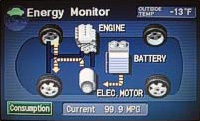
Most hybrids have an energy display screen mounted either in the instrument cluster or in the centre console. This is a small LCD which gives you, the driver, information about what mode you're driving in, and where the power is going. Again, the most recognisable and famous of these displays to date is that from the Toyota Prius (see right). The only real problem with these displays is the fascination they provide to the novice hybrid driver. Watching the animations spin around and the energy arrows scroll here and there as you drive is certainly informative but not really conducive to safe driving. One benefit however is the constantly-updated gas-mileage chart. Many Prius owners report that this spurs them to attempt to get videogame-like high scores in their cars, driving them in such a fashion as to get the highest recorded mpg from their cars. If nothing else, the energy display affects most drivers in terms of educating them as to how their driving style directly impacts their gas-mileage.
The battery question
At the time of writing, the estimated lifespan for the batteries in a hybrid car is about seven years before they need to be swapped out. The cost of doing this for the Toyota hybrids is now about US$3,000 which is a sizeable chunk of change (although a lot less than it was originally). The original theory was that you would have driven enough distance to recoup the extra cost via fuel savings but with the price of petrol where it is now, that is becoming harder and harder to achieve. So far there hasn't been a large recall for batteries for any of the hybrid manufacturers and I've not yet heard of anyone kicking up a stink about the cost. That means one of three things. (1) The batteries are lasting longer than expected, so people haven't had to swap them out yet. (2) They're paying the money but nobody has complained in the press. (3) The manufacturers are doing it free for good publicity.
Like the site? The page you're reading is free, but if you like what you see and feel you've learned something, a small donation to help pay down my car loan would be appreciated. Thank you.
Plug-in hybrids

It's been said that the reason the all-electric car failed in America is because if people forgot to plug it in overnight, they couldn't drive it the next day. The real reason had more to do with the politics of Big Oil, the California clean air act and GM's unwillingness to promote electric vehicles. Regular petrol-electric hybrids are an excellent choice for people wanting to be more frugal in their gas mileage, but the all-electric mode will only run for a couple of miles before the battery pack is completely drained. In fact, in the US, the Prius has been hobbled by the removal of the all-electric mode completely at the behest of Big Oil. The ideal solution to the pure-electric problem, and the petrol-electric problem is to have a plug-in hybrid. Essentially the idea is very simple. You drive the car as you would normally but you plug it in overnight. And extra set of deep-cycle marine batteries is charged up and can be used to drive in pure electric mode the following day. If the batteries run down, the car reverts to the behaviour of a normal petrol-electric hybrid. If you forget to plug it in overnight, again it behaves like a normal petrol-electric hybrid. In other words, if you choose to plug it in overnight, you buy yourself 30 or 40 miles of driving without using a single drop of petrol. If you forget, no biggie - you can still drive.
Famously, CalCars have converted a regular Prius to be a 100mpg+ vehicle with their plug-in conversion. Now to be fair, their vehicle doesn't actually do 100 miles by burning a single gallon of gas - that's a bit misleading. Using the gas-mileage figure is a convenient way of telling the consumer how their vehicle compares to other vehicles in a unit of measure that people understand. So how is this possible? Well the average commuter typically doesn't drive more than 30 miles a day. With the plug-in conversion, that entire distance is covered on pure electric mode, with the petrol engine only kicking in on a low charge or when it's needed for a burst of acceleration. Because the petrol engine is used so rarely, by the time you fill up, you can easily have covered more than 100 miles and only used a single gallon of petrol because most of that mileage was actually done in pure electric mode. CalCars will turn any hybrid into a plugin for you, for a price.
Diesel-electric hybrids
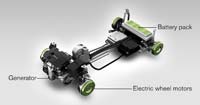 In 2011 Volvo launched the first diesel-electric hybrid - the V60 plugin - although it works just like a current-generation petrol-electric hybrid. Nobody yet manufactures a true diesel-electric hybrid - one that works just like a diesel-electric train. The small diesel engine is directly connected to a generator. The generator produces electricity on-demand, which is fed to wheel motors (electric motors built into the wheels) to drive the vehicle forwards. Volvo got close to this idea in 2007 with their ReCharge concept car, but never turned it into a full production vehicle. The benefits of this type of hybrid are obvious - no transmission, no driveshafts - a huge reduction in weight and complexity. In fact, these vehicles, if built, could almost be considered full EVs - fully electric vehicles. See the EV Bible for more information.
In 2011 Volvo launched the first diesel-electric hybrid - the V60 plugin - although it works just like a current-generation petrol-electric hybrid. Nobody yet manufactures a true diesel-electric hybrid - one that works just like a diesel-electric train. The small diesel engine is directly connected to a generator. The generator produces electricity on-demand, which is fed to wheel motors (electric motors built into the wheels) to drive the vehicle forwards. Volvo got close to this idea in 2007 with their ReCharge concept car, but never turned it into a full production vehicle. The benefits of this type of hybrid are obvious - no transmission, no driveshafts - a huge reduction in weight and complexity. In fact, these vehicles, if built, could almost be considered full EVs - fully electric vehicles. See the EV Bible for more information.
Picture credit: Volvo
The cost of hybrids
Because hybrid engine technology is still relatively new, it cost you more to buy a hybrid car than the equivalent petrol-engined car. Some countries, cities and states have incentives to do this, like energy grants, or paying the price difference. Ultimately, if you're willing to write-off the initial extra cost, owning a hybrid is definitely cheaper. If you include the extra cost up front and factor it across the lifetime of the vehicle, you'd need to own a hybrid for about 7 years covering about 15,000 miles a year to break even, given the rising cost of petrol compared to the mpg savings of operating the car. If you choose to go the plug-in hybrid route, you'll be paying even more for a company like CalCars to convert your car for you, but again, over the lifetime of ownership, you can probably recoup the cost within 5 years.
Renting hybrids

In July 2007, Hertz started to offer hybrids as an option for rental. Some Hertz locations allow you to specify the exact vehicle you want when you rent. There is of course a price premium, but for example if you were to rent from Hertz in England, because the cost of petrol over there is so prohibitively expensive, renting a hybrid will save you money as soon as you go over the 250 mile mark. Up to 250 miles, it's cheaper to rent a regular compact vehicle and fill it with petrol. Over 250 miles, the extra cost of the hybrid is negated by the fuel-saving and you're on your way to a cheaper overall rental.
First responder safety and hybrids
With the amount of electrical energy stored in Hybrid vehicles now, first responders need to be aware of the differences when they're attending crashes involving hybrids. The biggest safety concern is the high voltage battery pack and the high voltage lines that run along the underside of the car. If a rescue worker cuts through these by mistake, they'll be electrocuted, and that would be A Bad Thing. Most manufacturers have high voltage cutoffs on their battery supplies now, and all appear to have adopted a common colouring scheme for their wiring. Blue is intermediate voltage and orange is high voltage. The location and operation of the various systems differs from vehicle to vehicle and because of this, there are companies springing up that specialise in providing information and training courses specifically to address these issues. If you're interested in reading more, or you're a first responder who might be asked to deal with wrecked hybrids, Hybrid Hazards is one such company.
Are Hybrids really "green"?
This question gets asked a lot. As you drive the vehicle down the road, the answer is absolutely "yes" - a hybrid vehicle is far more green. But it's not just the car and your everyday driving that you have to consider. If you have a plug-in hybrid for example, the initial reaction is normally "of course it's green - I'm using electricity and that produces no exhaust". This is only true when you consider the vehicle in isolation. When you take into account the big picture, at some point a power station generated the electricity that was used to charge your plug-in hybrid. The power station might or might not have been clean - it could have been a coal-burning dinosaur, or it could have been a solar farm out in the desert. The assumption is that the chance of being able to control and regulate the pollution from a single powerplant is far greater than the chances of everyone keeping their emissions systems 100% in check.
What about the batteries themselves? They cost a lot to manufacture both in monetary terms and in terms of consumable items. Worse still, if they're not disposed of properly, they pollute landfills with toxic waste. That's not very green. Again some assumptions have to be made though - mass producing the batteries brings the cost down, whilst proper recycling of them ensures they don't pollute at the end of their useful life.
Taking it one step further - what about the plastics used in every car - not just hybrids. Are they recycled plastics? Can they themselves be recycled? Until the late 90's, most car plastics couldn't be recycled and would end up in landfills. Plastic isn't know for it's biodegradability.
So it's difficult to give a straight answer to the question of whether or not hybrids are really green. I think the best answer is that taken as a whole, hybrids are greener than most vehicles built to-date, but there's still a lot more that can be done.
It's not all about the powerplant
(or why aerodynamics are also important)
There's a good reason why the Prius looks the way it does. Toyota didn't deliberately design a nerd-mobile. They deliberately designed something which was aerodynamically clean. The unfortunate side-effect is that compared to more traditional car design, "aerodynamically clean" = "looks nerdy". So what are the key factors affecting how a car moves through the air and why is this important? Well the same air that you and I breathe is pretty thick stuff. You'd never know it to breathe it, but in the right situation, it makes for supersonic aircraft that grow in length and films about Apollo mishaps that have cliffhanger endings. Compared to a vacuum, air is very thick indeed and so anytime you push something through it, it generates drag. Drag is easy to understand - stick your arm out of the window next time you're driving. With the palm of your hand facing oncoming traffic, the aerodynamic drag will try to snap your arm off once you get to speed. But twist your hand so it's palm-down and suddenly it's much easier to keep your arm in place. The cross section of the side of your hand presents a much smaller area to the oncoming air which means less drag. Supposing you could now drive faster and faster, you'd eventually feel heat buildup on your hand because of the drag, and if you could go fast enough, you'd end up with a bloody stump which, because of the heat, would also be neatly cauterised at the same time. Best not try that then.
Reducing aerodynamic drag
Aerodynamic drag is an odd thing in that it's not a linear function. In other words, the amount of drag on an object at 40mph is not double the drag experienced on the same object at 20mph. Because we're not writing a physics paper here, it's simplest to think of frictional drag as being roughly proportional to the square of the velocity:

where p = air density, A is the cross sectional area, C is the coefficient of drag and v is the speed.
This means that you get more drag with:
- denser air
- larger cross section
- higher coefficient of drag
- more speed
Well there's not a car designer can do about air density so that part of the equation is entirely down to mother nature. The cross section is something that can be altered though - making a car have a smaller frontal area means it induces less drag. It's why the hand experiment I talked about above works like it does - when you turn your hand palm-down, you're massively reducing 'A' in the equation above, so you get less drag. Coefficient of drag is a complicated topic, but suffice to say it can be affected by anything from the slope of the radiator and windscreen to the size of the door handles to wheel wells to aerials. See the sections on reducing the coefficient of drag below. The only thing you, the driver, can control is v - your speed. The faster you go, the more drag on your vehicle. The more drag, the more energy the engine has to spend to push you through the air. Slow down and you get better fuel economy.
So the key to all this is reducing frictional drag - anything that can be done to reduce this value will naturally increase the fuel economy of a vehicle because the engine will expend less energy (and thus burn less fuel) to move the car through the air. And this is why the Prius looks like it does - because the designers went for a smaller frontal cross section combined with a lower coefficient of drag. So the best way to think of this is the Drag Area of a vehicle:
Drag Area
The drag area of a vehicle is determined by multiplying its cross sectional area by its coefficient of drag. The table below shows a couple of examples that most people will be familiar with - the Toyota Prius (second generation) and the Hummer H2. (figures from Rüdiger Cordes' Opel GT page)
| Prius | Hummer | |
|---|---|---|
| Drag coefficient | 0.26 | 0.57 |
| Frontal area | 2.23m² | 4.29m² |
| Drag Area | 0.579 | 2.44 |
If you learn nothing else here, then understand that table above and you'll understand why vehicles perform how they do. The Hummer has a much larger frontal area, because of it's size, and a much larger coefficient of drag, because of (amongst other things) the vertical radiator grille and near-vertical windscreen. Combined, it means that for the same size of engine, a Hummer expends over four times the amount of energy to move it through the air.
Reducing the coefficient of drag
Picture credits: www.hondauk-media.co.uk, evworld.com, Citroën
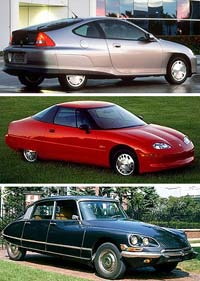
There are all sorts of things that can be done to a vehicle to reduce the coefficient of drag. If you're into cars, most of you will recognise the 1999 Honda Insight's faired-in rear wheels. They looked odd but were designed like that for a reason. By being faired-in, the rear wheel arch was removed so air was no longer forced to pass a spinning wheel in a gaping hole in the bodywork. That caused turbulence, which caused drag, which increased the drag coefficient. By making smooth body panels that covered the wheels, Honda created a more streamlined shape, less likely to cause turbulence. It's worth pointing out that Honda didn't get there first though. GM re-introduced this particular styling cue in 1996 on their fully electric EV1. I say 're-introduced' because in 1955, Citroën got there a full 44 years earlier with their DS model.
Anything that creates turbulence will induce drag, and so increase the coefficient of drag. For example removing the rear view mirrors does two things - it removes two items that poke out from the side of the car which create turbulence, as well as reducing the frontal cross section. Both of these affect the overall aerodynamic drag formula above, but it's not really wise for designers to simply remove rear view mirrors. Instead, they make smaller, more streamlined mirrors designed to present less frontal cross section, and importantly, to create less drag.
Another styling and design cue mimicked from the DS is the overall shape of the car - wider at the front and tapering to a narrower rear, both in side view and plan view. Why is this? Well it's because that is how car designers begin to approach the most aerodynamic shape there is.
What's the most aerodynamic shape?


If you think of air as a fluid, then think of what nature created to best cut through water, it won't surprise you to know that the most aerodynamic shape looks like a fish or a teardrop - the shape water naturally forms when it falls through air. A wide, circular front moves the air aside, compressing it with minimal fuss, whilst a long sculpted tail allows the air to expand again in the low pressure area behind the shape without creating turbulence. If you've ever been to Speed Week on the Bonneville Salt Flats, you'll have seen drop-tank or belly-tank racers. These guys take old world war 2 era aircraft drop tanks and build cars out of them. Those old drop tanks were designed to be added to aircraft to increase range (by carrying more fuel) without a massive increase in drag (which would have negated the whole excercise). They're the perfect aerodynamic shape. So vehicles like the EV1, the Citroën DS and the Honda Insight all attempt to get to a usable version of this shape as best they can.
Picture credits: www.so-calspeedshop.com
Did Citroën really get there first?

For the history buffs, here's a nugget of trivia : Romanian engineer Aurel Perşu actually came to the conclusion that the teardrop was the best shape in 1922 and built a vehicle to prove it. He patented the shape in 1924 and both Ford and GM expressed an interest in buying the patent at the time, but since they didn't want to commit to also building the car, Perşu refused their offers. That vehicle had a drag coefficient of 0.22 - lower than most vehicles today - and it's still fully functional and on display at the Romanian National Technical Museum in Bucharest. Since 2006, the museum has awarded an annual Aurel Perşu Aerodymanic Automobile prize to the car manufacturer that produced a vehicle in the previous model year with a drag coefficient lower than 0.3. In 2006 the Mercedes S-Class took the prize and in 2007 the prize was given to Toyota Corolla.
What the heck was that all about?
You might get to this point and wonder why there's a whole bunch of guff about aerodynamics on a page dedicated to hybrid vehicles. Simple - whilst the hybrid drivetrain is important, other factors play a role too. One of the more important ones is the shape of the car. The more a designer can do to make a car cut through the air more cleanly, the less engine capacity required to do so, or the more efficient a given size of engine can become. It's pointless designing a Hybrid Hummer or SUV (even though GM have already done so) without taking other factors in to consideration. Without a change to the aerodynamic shape, drag-inducing appendages and excess weight, a hybrid SUV is about as effective as a fart in a hurricane.
